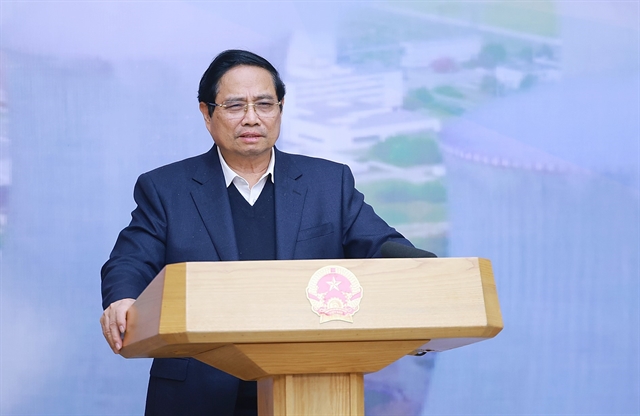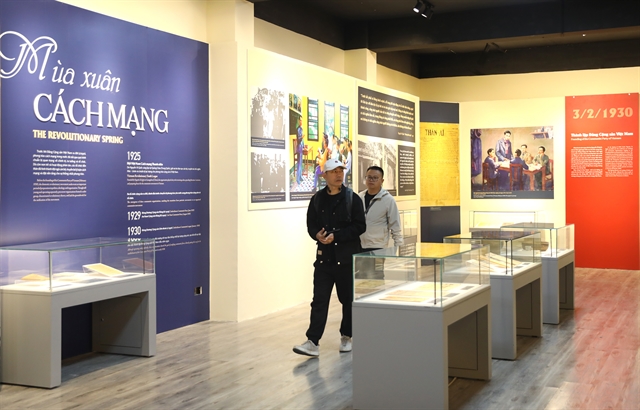 Life & Style
Life & Style

Annual Hùng King Memorial Day falls on the 10th of the third lunar month of the year, when Vietnamese living elsewhere in the country find their way to go to Việt Trì city and pay tribute to the ancestors of all Vietnamese people.
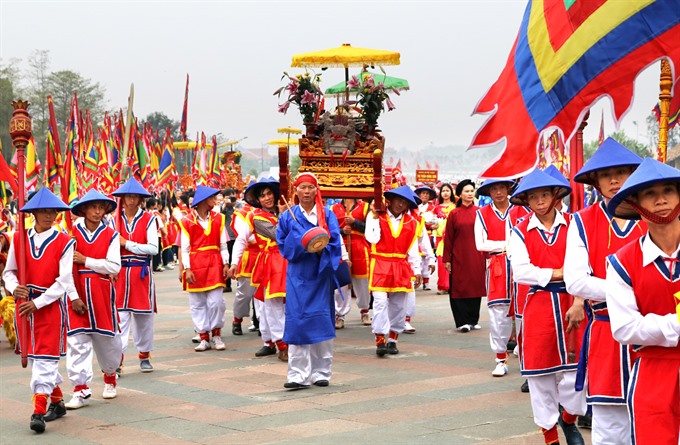 |
| Ceremonial: A long-standing tradition is maintained, with soldiers in traditional attire accompanying the palanquin. — VNS Photo Nguyễn Trung Kiên |
VIỆT TRÌ — “When we drink water, we remember its sources.
“When we eat a sweet fruit, we are grateful to those who plant it.”
Gratitude to ancestors is an axiom of Vietnamese life and culture, and the event that gives greatest expression to this gratitude is the Hung Kings Memorial Day, which falls on the 10th of the third lunar month (which falls on April 6 this year on the Gregorian calendar).
The nation as a whole pays tributes to its legendary founders on this day.
After lighting incense at the Celestial Temple on top of Nghĩa Lĩnh Mountain to pay tributes to the nation’s founders, Lê Hồng Vân, chairman of Việt Trì City’s People’s Committee, cited the above-mentioned homilies on gratitude.
“These are the reminders that are handed down from generation to generation,” he said.
At 6.30am sharp, many people were standing in line for the nonstop, uphill walk to the top of the Nghĩa Lĩnh Mountain, where the 6th King Hùng Huy Vương of the Vietnamese legend was buried.
Vietnamese people from all parts of the country had made their way to Việt Trì City to pay their tributes to their ancestors.
“We come here from Bình Dương Province,” Đặng Thị Giàu told Việt Nam News. “There’s one temple dedicated to the Hùng Kings at the Đại Nam Complex near where we live."
“But this is the original site where our ancestors were buried so we want to come here,” she said as she prepared to light incense and pray at the Celestial Temple.
In the last six years, Giàu has been here five times with a group of six friends in their 70s and 80s.
But it is not just the elderly who take the 500 or so steps to the temple atop the mountain. Many young people, students, and people of all ages and walks of life come here to connect with their roots.
It is estimated that over the last two days, a staggering two million people have visited Hùng King’s Temple, truly the country’s biggest pilgrimage site every year.
Leading an entourage of more than 100 civil servants in Việt Trì and a royal carriage on the shoulders of a dozen strong men to the mountain top, Lê Hồng Vân, chairman of Việt Trì People’s Committee, lit incense in the inner altar, open to a very limited number of people.
“Today we stand at the Celestial Temple at the top of the sacred Nghĩa Lĩnh Mountain with enormous gratitude toward our ancestors: the Hùng Kings, our nation’s founding fathers,” he said.
“We share a common heritage,” he continued, “and all of us commemorate the Hùng Kings Memorial Day every year. It is our tradition, our common background, our great unity.”
Legends and artifacts
Vietnamese people tend to disagree with each others on many things, but there is no difference of opinion on one important thing that the Hùng Kings are our ancestors.
The blend of history and legend has it that the first ruler of what is Việt Nam today was Kinh Dương Vương, a great-grandson of the Agriculture God, who looks over all farming work in Heaven. He then married the Dragon Queen and give birth to Lạc Long Quân, or Dragon King.
Lạc Long Quân met his future wife Âu Cơ, or the Phoenix Queen in a cave during one of his travels around his kingdom. He took her to settle down at the Nghĩa Lĩnh Mountain. The couple gave birth to one hundred men.
One day Lạc Long Quân told his wife, “My dear, I belong to the Dragon family, while you to the Fairy family. So we cannot live together for long.”
So when their sons become adults, Lạc Long Quân sent 50 sons to go with their Mother Âu Cơ to live in the mountains. He took 49 other sons and headed out to sea.
They left their eldest son Hùng Quốc Vương to rule the country known as Văn Lang.
Hùng Quốc Vương lived in the Văn Lang Citadel, now Việt Trì City. The Hùng dynastry lasted for 18 generations.
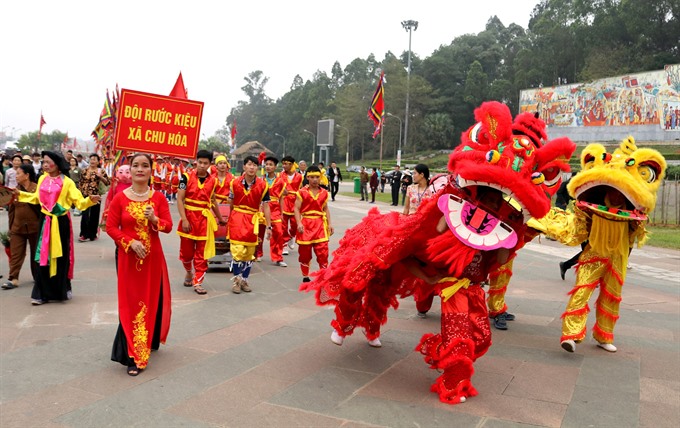 |
| Dragon steps: The palanquin team from Chu Hóa Commune at the foot of the Nghĩa Lĩnh Mountain is accompanied by a dragon dance team. — VNS Photo Nguyễn Trung Kiên |
In his book, The Hùng Kings Temple — Historic Memorial, writer Vũ Kim Biên lists all the 19 Hùng Kings and the duration of their reigns.
But legend has also been infused into the list. It is said the first Hùng King ruled for 221 years and lived up to 260 years, and that the second Hùng King ruled for 300 years and lived up to 646 years.
While these are obviously legends orally handed down from ancient times, some of the “legendary” stuff has been supported by artifacts unearthed by archaeologists.
The last Hùng King did not have a son to continue his lineage, so he gave the throne to a nephew. Thục Phán An Dương Vương defeated the last of the Hùng Kings in 257BC.
Later, Thục Phán lost his kingdom to the neighbouring Qin dynasty’s general Zhao Tuo, who used his son to seduce, marry and gradually steal weaponry secrets from the daughter of Thục Phán An Dương Vương. This story, known to every Vietnamese, is purportedly a legend, but several details of the story are backed by real-life artifacts.
The earthen spiral citadel, or Cổ Loa, 16km northeast from central Hà Nội, was the location of the Âu Lạc Kingdom, with Thục Phán as King An Dương Vương.
The giant turtle’s claw, used as trigger on the magical crossbow that can fire thousands of bronze arrows at a time, is the stuff of legends. Many bronze arrows can be seen today at the National Museum of History in Hà Nội.
Archaeologists have also found bronze drums at the Cổ Loa Citadel site. Produced in 600BC or even earlier, the drums are one of the finest examples of metal works creted by the Đông Sơn Culture. Weighed up to 100 kilos each, the drums are intricately decorated with geometric patterns, scenes of daily life, wartime, birds and other animals, and boats. The drums were objects of trade and family heirlooms.
Same ancestors
The Vietnamese people have always valued the dedication and sacrifice of previous generations and see the anniversaries of their death as an opportunity to pay tributes. This custom is observed by every family, with children sharing the cost of the family feast or making the best offerings they can at the ancestors’ altar.
The same tradition applies when it comes to worshipping the national founding fathers.
This year four localities, including Hà Nội, Thái Bình, Bình Phước and Bến Tre Province, offered to co-host the ceremonies and series of accompanying activities during the Hùng Kings Memorial Day.
“I am the master of ceremonies and I have been entrusted to chair the ceremony commemorating the Hùng Kings,” said Lương Phú Thuận, 80.
“Vietnamese, wherever life takes you to,” he said, “remember to turn your heart and soul toward the Hùng Kings Temple. The Kings will bless you.” — VNS
 |
| Ceremonial: A long-standing tradition is maintained, with soldiers in traditional attire accompanying the palanquin. — VNS Photo Nguyễn Trung Kiên |
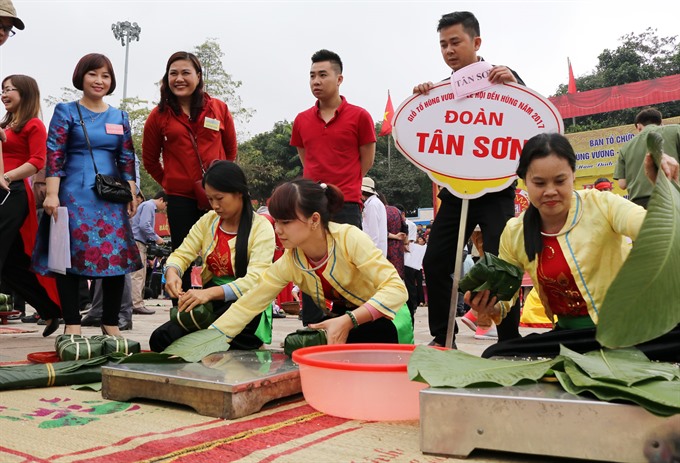 |
| Food story: It is said that Prince Lang Liêu, the youngest and poorest son of the 18th Hùng King, invented the square and round sticky rice cakes to gift his parents. This is a tradition maintained by the Vietnamese people ever since. — VNS Photo Trung Kiên |
24562158PM.JPG) |
| Fast work: Teams compete to wrap banh chung cakes in Việt Trì City, a tradition handed down by the Hùng Kings. — VNS Photo Nguyễn Trung Kiên |
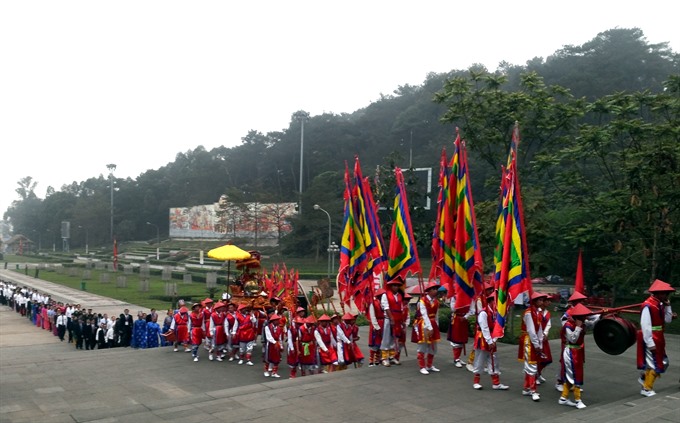 |
| Orderly departure: Locals carry traditional flags, a large palanquin with offerings to walk up nearly 500 steps to the Upper Temple. — VNS Photo Đoàn Tùng |
 |
| On the way up: People of Việt Trì City on their way to honour Hùng Kings. VNS Photo Đoàn Tùng |


